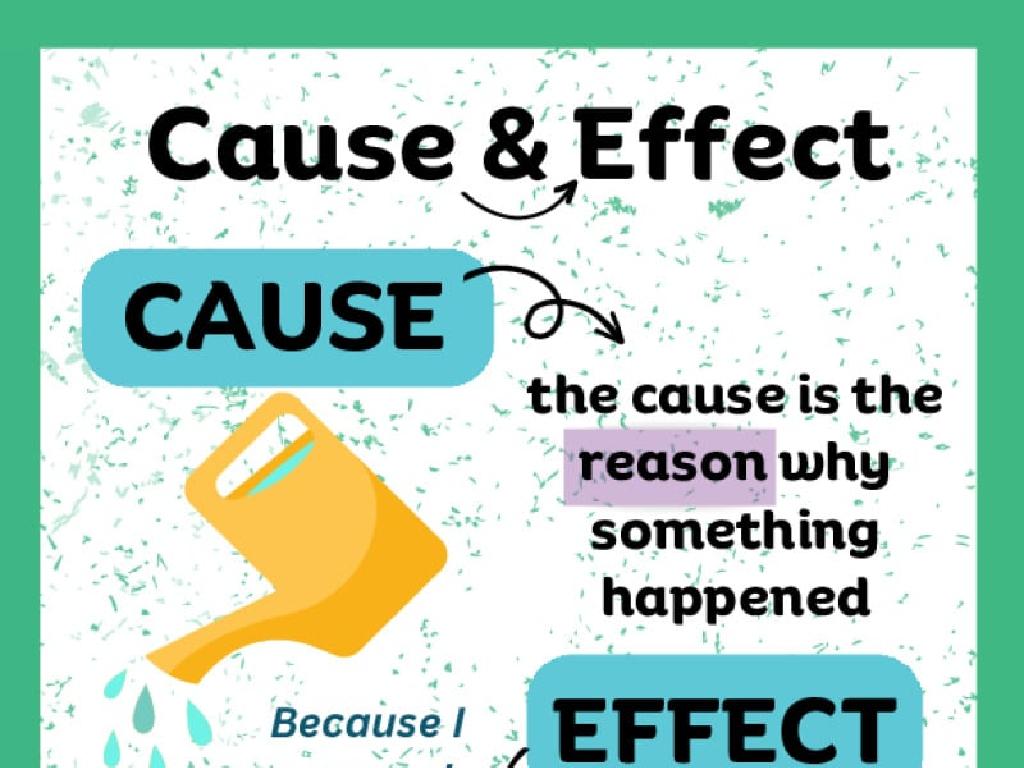Powers With Decimal And Fractional Bases
Subject: Math
Grade: Seventh grade
Topic: Exponents
Please LOG IN to download the presentation. Access is available to registered users only.
View More Content
Introduction to Exponents
– Recap: What are exponents?
– Exponents show how many times to use a number in a multiplication.
– Base and exponent explained
– Base is the number being multiplied; exponent tells how many times.
– Examples: Whole number exponents
– 2^3 means 2 multiplied by itself 3 times, which equals 8.
– Practice with simple exponents
– Let’s calculate 3^2, 4^1, and 5^3 together.
|
Begin with a brief review of exponents, ensuring students recall that exponents represent repeated multiplication. Clarify the terms ‘base’ and ‘exponent,’ with the base being the number that is multiplied by itself, and the exponent indicating the number of times this multiplication occurs. Provide clear examples using whole numbers to solidify understanding. Engage the class with practice problems to apply their knowledge of simple exponents with whole numbers, preparing them for more complex concepts like decimal and fractional bases.
Understanding Decimal Bases in Exponents
– Decimal numbers as bases explained
– Decimal bases function like whole numbers in exponents but with non-integer values.
– Reading and writing decimal exponents
– Write the base as a decimal followed by the exponent, e.g., 2.3^4.
– Example: Calculating 1.5^3
– 1.5^3 means 1.5 multiplied by itself 3 times: 1.5 * 1.5 * 1.5.
|
This slide introduces students to the concept of using decimal numbers as bases in exponents. Emphasize that while the base is not a whole number, the rules for exponents remain the same. Show how to read and write these expressions, such as 2.3 to the fourth power, written as 2.3^4. Use the example of 1.5^3 to demonstrate the calculation process: multiplying 1.5 by itself three times. Encourage students to practice with additional examples and to consider the real-world applications of decimal bases, such as in financial calculations involving interest rates.
Exponents with Fractional Bases
– Understanding fractions as bases
– A fraction as a base is raised to a power
– Reading and writing fractional exponents
– Exponents with fractions: (a/b)^n
– Example: (3/4)^2 calculation
– (3/4)^2 means (3/4) multiplied by itself
– Practice with more examples
|
This slide introduces the concept of using fractions as bases in exponents. Begin by explaining that fractions can also be bases, just like whole numbers, and they follow the same rules for exponents. Show how to read and write exponents with fractional bases, emphasizing the notation and pronunciation. Use (3/4)^2 as a concrete example to demonstrate the process of multiplying a fraction by itself. Encourage students to work through additional examples to solidify their understanding, and ensure they grasp the concept of squaring a fraction before moving on to more complex operations with fractional exponents.
Properties of Powers: Decimal & Fractional Bases
– Multiplying powers with same base
– When bases are same, add exponents: (3.5^2) * (3.5^3) = 3.5^(2+3)
– Dividing powers with same base
– With same bases, subtract exponents: (7/2^4) / (7/2^2) = 7/2^(4-2)
– Power of a power: decimals & fractions
– Multiply exponents for power of a power: (0.6^3)^2 = 0.6^(3*2)
– Simplifying complex expressions
|
This slide introduces the properties of powers when dealing with decimal and fractional bases. Emphasize that the rules for multiplying and dividing powers with the same base are the same regardless of whether the base is a whole number, decimal, or fraction. When multiplying, add the exponents; when dividing, subtract the exponents. For a power of a power, multiply the exponents. Use examples to illustrate each property and provide practice problems for students to apply these rules. Encourage students to simplify complex expressions by recognizing patterns and applying these properties systematically.
Solving Exponent Problems with Decimals and Fractions
– Apply exponent properties
– Decimal base problem guide
– Step 1: Write down the decimal base. Step 2: Apply the exponent. Step 3: Simplify the result.
– Fractional base problem guide
– Step 1: Convert fraction to decimal. Step 2: Apply the exponent. Step 3: Convert back if needed.
– Practice with examples
– Example: (0.5)^3 or (3/4)^2. Try solving these!
|
This slide is aimed at teaching students how to solve exponent problems with decimal and fractional bases. Start by reviewing the properties of exponents, such as the product of powers property and the power of a power property. Then, guide students through a step-by-step process for solving problems with decimal bases, emphasizing the importance of place value and careful calculation. Next, provide a similar guide for fractional bases, including how to convert fractions to decimals if necessary. Encourage students to practice with provided examples and to check their work by converting their answers back to fractions to ensure accuracy. This will help solidify their understanding of the concepts and improve their problem-solving skills.
Class Activity: Exponent Exploration
– Pair up and solve problems
– Present problem and solution
– Discuss different solving methods
– Reflect on learning outcomes
Consider how different approaches can lead to the same answer.
|
This activity is designed to encourage collaborative learning and peer teaching. Students will pair up to work through problems involving exponents with decimal and fractional bases, which can be challenging concepts at this level. After solving the problems, each pair will present their findings to the class, fostering a sense of accomplishment and public speaking skills. During presentations, encourage active listening and note-taking. After all pairs have presented, lead a class discussion on the various methods used to solve the problems, highlighting that different approaches can be valid. Conclude with a reflection on what was learned and how these skills apply to real-world scenarios. Possible activities: 1) Comparing exponential growth rates, 2) Calculating compound interest with different rates, 3) Exploring scientific notation with small decimals, 4) Fractional growth in biology or population studies.
Conclusion: Powers with Decimal and Fractional Bases
– Recap: Decimal & Fractional Powers
– Review how to calculate powers with non-integer bases.
– Exponents in Real Life
– Understanding exponents is crucial for scientific calculations and finance.
– Homework: Practice Problems
– Solve assigned problems to master the concept.
– Next Class: Q&A Session
– Be prepared to discuss any difficulties faced.
|
As we wrap up today’s lesson on powers with decimal and fractional bases, it’s important to revisit the key concepts to ensure understanding. Emphasize the practical applications of exponents in fields like science and finance, where they are used to express large numbers or growth rates. Assign practice problems for homework to reinforce the day’s lesson. Encourage students to attempt these problems and bring up any questions or challenges they encounter in the next class, where we will have a Q&A session to address these issues. This will help solidify their grasp on the topic and build confidence in using exponents with non-integer bases.





